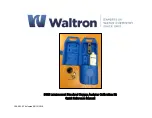
Where:
N
Number of traces in the measurement.
mean
Average number of states in the range per trace.
S
sumq
Sum of squares of states in the range per trace.
Symbols within range Names of other symbols that identify addresses or ranges
of addresses within the range of this symbol.
Additional symbols
for address
Names of other symbols that also identify this address.
Some compilers emit more than one symbol for certain
addresses. For example, a compiler may emit
"math_library" and "_math_library" for the first address in
a routine named math_library. The analyzer will show the
first symbol it finds to represent a range of addresses, or a
single address point, and it will show the other symbols
under either "Symbols within range" or "Additional
symbols for address", as applicable. In the "math_library"
example, it may show either "math_library" or
"_math_library" to represent the range, depending on
which symbol it finds first. The other symbol will be
shown below "Symbols within range" in the report. These
conditions appear particularly in default measurements that
include all global and local symbols.
Relative and absolute
counts
Relative count is the total number of states associated with
the address ranges in the performance measurement.
Relative time is the total amount of time associated with
the address ranges in the performance measurement. The
absolute counts are the number of states or amount of time
associated with all the states in all the traces.
Chapter 7: Making Software Performance Measurements
To use the Software Performance Measurement Tool
297
Summary of Contents for 64783A
Page 30: ...xxx ...
Page 31: ...Part 1 Quick Start Guide 1 ...
Page 33: ...1 Getting Started 3 ...
Page 70: ...40 ...
Page 75: ...Part 2 Using The Emulator 45 ...
Page 140: ...110 ...
Page 141: ...4 Using the Emulator How to control the processor and view system resources 111 ...
Page 227: ...5 Using the Emulation Bus Analyzer How to record program execution in real time 197 ...
Page 290: ...260 ...
Page 331: ...8 Configuring the Emulator 301 ...
Page 382: ...352 ...
Page 383: ...9 Solving Problems What to do when the emulator doesn t behave as expected 353 ...
Page 397: ...Part 3 Reference 367 ...
Page 399: ...10 Using Memory Management Understanding logical and physical emulation and analysis 369 ...
Page 429: ...11 Emulator Commands The command syntax reference for the emulator softkey interface 399 ...
Page 443: ...copy Chapter 11 Emulator Commands copy 413 ...
Page 451: ...display Chapter 11 Emulator Commands display 421 ...
Page 457: ...DISPLAY MEMORY Chapter 11 Emulator Commands DISPLAY MEMORY 427 ...
Page 461: ...DISPLAY MMU Chapter 11 Emulator Commands DISPLAY MMU 431 ...
Page 464: ...DISPLAY TRACE Chapter 11 Emulator Commands DISPLAY TRACE 434 ...
Page 480: ...modify Chapter 11 Emulator Commands modify 450 ...
Page 501: ...set Chapter 11 Emulator Commands set 471 ...
Page 514: ... SYMB Chapter 11 Emulator Commands SYMB 484 ...
Page 582: ...552 ...
Page 583: ...13 Setting X Resources 553 ...
Page 598: ...568 ...
Page 606: ...576 ...
Page 613: ...16 Specifications and Characteristics 583 ...
Page 627: ...Part 4 Concept Guide 597 ...
Page 629: ...17 X Resources and the Graphical User Interface 599 ...
Page 639: ...Part 5 Installation and Service Guide 609 ...
Page 697: ...19 Installation and Service 667 ...
Page 746: ...Chapter 19 Installation and Service Verifying the Installation 716 ...
Page 755: ...20 Installing Updating Emulator Firmware 725 ...
Page 762: ...732 ...
Page 778: ...748 ...
Page 810: ...X server 554 604 X Window System 54 Index 780 ...
















































